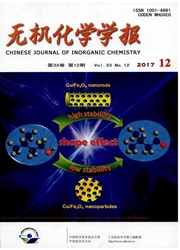

 中文摘要:
中文摘要:
通过5-(4-甲酸基苯基)-10,15,20-三(4-十二烷氧基苯基)卟啉(HAcTPP)与乙二胺,丙二胺和丁二胺反应,制备了一类含2个酰胺基团的卟啉二聚体C2(AmTPP)2、C3(AmTPP)2和C4(AmTPP)2以及相应的配合物Pt2C2(AmTPP)2、Pt2C3(AmTPP)2和Pt2C4(AmTPP)2。采用1H NMR、13C NMR、质谱、元素分析、循环伏安、紫外-可见吸收光谱和荧光发射光谱等对二聚体的化学结构、热稳定性、电化学和光物理性质进行了表征。实验发现,二聚体和相应的铂配合物的光致发光(PL)光谱性质与溶液的浓度有关,在10-7 molL-1 THF稀溶液中,二聚体与单羧基卟啉的PL光谱基本一致。当浓度增加到10-3 molL-1 THF溶液时,二聚体的光致发光光谱最大值从657 nm红移到675 nm,比单羧基卟啉红移了18 nm。当与金属铂配位后,这种发射光谱随浓度增加而变化的特性更加明显。二聚体配合物在10-7 molL-1 THF稀溶液中PL光谱就产生了红移现象,最大发射峰λmax为673 nm,比单羧基卟啉红移16 nm。在高浓度10-4 molL-1 THF溶液和升华薄膜中的PL最大发射峰进一步红移到727 nm的近红外区。进一步,为了证实二聚体配合物分子间的π-π和Pt-Pt相互作用,我们以配合物Pt2C3(AmTPP)2为例,对二聚体配合物固体在常温和低温77 K的PL光谱进行了测试,发现固体配合物表现出与温度相关的PL性质。当温度降到77 K时,配合物的最大发射峰从658 nm红移到674 nm,红移了16 nm。实验表明,卟啉二聚体和相应的配合物的红移现象与二聚体的分子结构直接相关,卟啉二聚体中的两个酰胺基团能够产生较强的分子间氢键,导致二聚体分子之间产生一定程度的π-π和Pt-Pt相互作用,使得二聚体PL光谱产生红移。
 英文摘要:
英文摘要:
A new series of dimeric porphyrins with two amide groups linkage and the corresponding platinum(Ⅱ) complexes were synthesized by the amidation of ethylenediamine, 1,3-diaminopropane and 1,4-diaminobutane with 5-(4-carboxy-phenyl)-10,15,20-tri-(4-dodecyloxyphenyl) porphyrin (HAcTPP) and characterized by 1H NMR, 13C NMR, MS, elemental analysis, cyclic voltammetry, UV-Vis and fluorescent spectrometer. It is found that photoluminescence (PL) spectra for the dimers show concentration dependences. In dilute solution (10-7 molL-1), maxima of PL peak for dimers was located at 657 nm, which has identical PL peak with single porphyrin, HAcTPP. When concentration was increased to 10-3 molL-1, the maximal PL peak value (675 nm) for the dimeric porphyrins exhibited 18 nm bathochromic shift (relative to single porphyrin, HAcTPP). Moreover, the concentration dependence PL spectra become more sensitive for dimeric complexes that were obtained by refluxing dimeric porphyrin with PtCl2 in benzonitrile solution. The maximal PL peak values (about 673 nm) for dimers complexes showed 16 nm red-shifts compared with that for HAcTPP even in 10-7 molL-1 dilute THF solution. With concentration increase to 10-4 molL-1, the emission peak for complexes of dimeric porphyrin was at 727 nm, which is red-shifted to near-infrared range. To examine the correlation between the luminescence and intermolecular π-π and/or Pt(Ⅱ)-Pt(Ⅱ) interactions for the dimeric complexes, the solid-state luminescence for the dimeric complex, Pt2C3(AmTPP)2, at room temperature and 77 K was measured, which showed low-energy emissions with a maximum at 658 nm at room temperature. Upon cooling the solid sample to 77 K, the solid sample exhibited red-shift of 16 nm (from 658 to 674 nm) and there was more structured spectrum with an additional weak emission at 706 nm. Furthermore, sublimating films of the complexes also yielded red-shift emission at about 727 nm and broadened PL profile with an additional tailing a
 同期刊论文项目
同期刊论文项目
 同项目期刊论文
同项目期刊论文
 Crystal structure of (2-{3-[4-(40-cyanobiphenyl- 4-yloxy)butoxy]pyridin-2-yljN}- 5-(dodecyloxy)pheny
Crystal structure of (2-{3-[4-(40-cyanobiphenyl- 4-yloxy)butoxy]pyridin-2-yljN}- 5-(dodecyloxy)pheny SYNTHESIS, SPECTRAL CHARACTERISTICS OF CDTE/CDS CORE/SHELL QUANTUM DOTS AND CARBAZOLE ABUTMENT CYANI
SYNTHESIS, SPECTRAL CHARACTERISTICS OF CDTE/CDS CORE/SHELL QUANTUM DOTS AND CARBAZOLE ABUTMENT CYANI PRERARATION OF CDTE/CDS CORE-SHELL QUANTUM DOTS MODIFIED BY CHITOSAN AND ITS SPECTRAL CHARACTERISTIC
PRERARATION OF CDTE/CDS CORE-SHELL QUANTUM DOTS MODIFIED BY CHITOSAN AND ITS SPECTRAL CHARACTERISTIC 期刊信息
期刊信息
